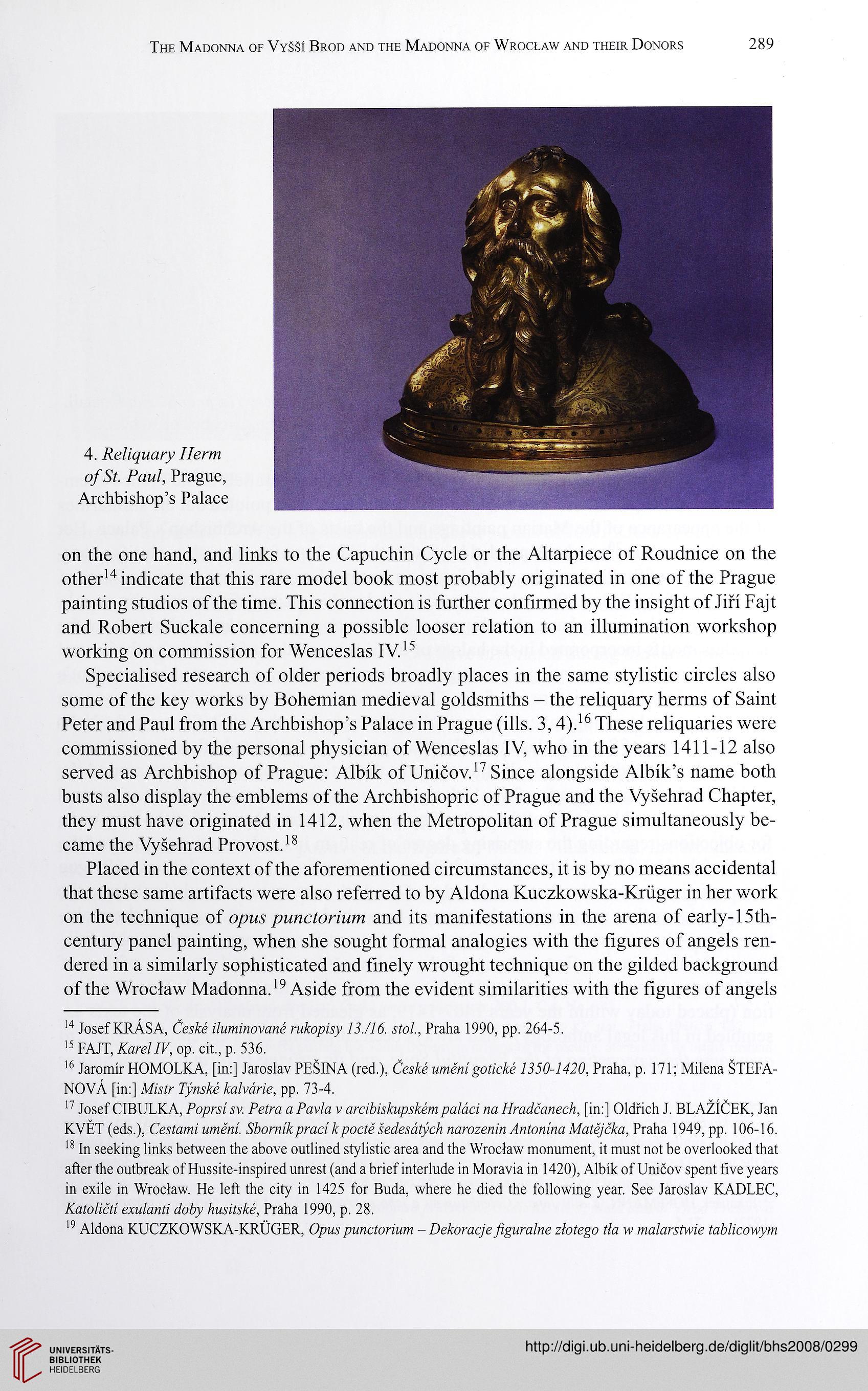THE MADONNA OF VYSSI BROD AND THE MADONNA OF WROCŁAW AND THEIR DONORS
289
4. /A//<yn<3ry /Verw
of^/. PoM/, Prague,
Archbishop's Palace
on the one hand, and links to the Capuchin Cycle or the Altarpiece of Roudnice on the
other^ indicate that this rare model book most probably originated in one of the Prague
painting studios of the time. This connection is further confirmed by the insight of Jin Fajt
and Robert Suckale concerning a possible looser relation to an illumination workshop
working on commission for Wenceslas IVV
Specialised research of older periods broadly places in the same stylistic circles also
some of the key works by Bohemian medieval goldsmiths - the reliquary herms of Saint
Peter and Paul from the Archbishop's Palace in Prague (ills. 3,4) V These reliquaries were
commissioned by the personal physician of Wenceslas IV, who in the years 1411-12 also
served as Archbishop of Prague: Albik of UnicovV Since alongside Albik's name both
busts also display the emblems of the Archbishopric of Prague and the Vysehrad Chapter,
they must have originated in 1412, when the Metropolitan of Prague simultaneously be-
came the Vysehrad Provost.^
Placed in the context of the aforementioned circumstances, it is by no means accidental
that these same artifacts were also referred to by Aldona Kuczkowska-Krüger in her work
on the technique of jornrc/on'Min and its manifestations in the arena of early-15th-
century panel painting, when she sought formal analogies with the figures of angels ren-
dered in a similarly sophisticated and finely wrought technique on the gilded background
of the Wroclaw Madonna.^ Aside from the evident similarities with the figures of angels
'4 Josef KRASA, (AsA //uaimované nAop/sy /3./Z6. Vo/., Praha 1990, pp. 264-5.
FAJT, Karg//P, op. cif, p. 536.
'6 Jaromir HOMOLKA, [in:] Jaroslav PEŚINA (red.), (Asie maea/got/cAé 7350-/426, Praha, p. 171; Milena ŚTEFA-
NOVÂ [in:] Mvr 7)As/A Æa/varte, pp. 73-4.
' Josef CIBULKA, Poprs/ .su Petra a Pav/a v arc/O/Aaßs/A??? pa/âc/ a a Prar/caaec/i, [in:] Oldrich J. BLAZlCEK, Jan
KVET (eds.), C'astaaa aaien/. SPoraA prac/ /cpoetę .śec/e.sćtyc/? aaaozea/a daZoa/aa Afate/'cka, Praha 1949, pp. 106-16.
's ln seeking links between the above outlined stylistic area and the Wroclaw monument, it must not be overlooked that
after the outbreak of Hussite-inspired unrest (and a brief interlude in Moravia in 1420), Albik of Unicov spent five years
in exile in Wroclaw. He left the city in 1425 for Buda, where he died the following year. See Jaroslav KADLEC,
Aato/Zct/ axa/aat/ AAy /laVts/A, Praha 1990, p. 28.
^ Aldona KUCZKOWSKA-KRÜGER, Opas paactor/aai - Dekarac/'e //gara/ae z/otego t/a w wa/arVu-u? ta/A/cowy/a
289
4. /A//<yn<3ry /Verw
of^/. PoM/, Prague,
Archbishop's Palace
on the one hand, and links to the Capuchin Cycle or the Altarpiece of Roudnice on the
other^ indicate that this rare model book most probably originated in one of the Prague
painting studios of the time. This connection is further confirmed by the insight of Jin Fajt
and Robert Suckale concerning a possible looser relation to an illumination workshop
working on commission for Wenceslas IVV
Specialised research of older periods broadly places in the same stylistic circles also
some of the key works by Bohemian medieval goldsmiths - the reliquary herms of Saint
Peter and Paul from the Archbishop's Palace in Prague (ills. 3,4) V These reliquaries were
commissioned by the personal physician of Wenceslas IV, who in the years 1411-12 also
served as Archbishop of Prague: Albik of UnicovV Since alongside Albik's name both
busts also display the emblems of the Archbishopric of Prague and the Vysehrad Chapter,
they must have originated in 1412, when the Metropolitan of Prague simultaneously be-
came the Vysehrad Provost.^
Placed in the context of the aforementioned circumstances, it is by no means accidental
that these same artifacts were also referred to by Aldona Kuczkowska-Krüger in her work
on the technique of jornrc/on'Min and its manifestations in the arena of early-15th-
century panel painting, when she sought formal analogies with the figures of angels ren-
dered in a similarly sophisticated and finely wrought technique on the gilded background
of the Wroclaw Madonna.^ Aside from the evident similarities with the figures of angels
'4 Josef KRASA, (AsA //uaimované nAop/sy /3./Z6. Vo/., Praha 1990, pp. 264-5.
FAJT, Karg//P, op. cif, p. 536.
'6 Jaromir HOMOLKA, [in:] Jaroslav PEŚINA (red.), (Asie maea/got/cAé 7350-/426, Praha, p. 171; Milena ŚTEFA-
NOVÂ [in:] Mvr 7)As/A Æa/varte, pp. 73-4.
' Josef CIBULKA, Poprs/ .su Petra a Pav/a v arc/O/Aaßs/A??? pa/âc/ a a Prar/caaec/i, [in:] Oldrich J. BLAZlCEK, Jan
KVET (eds.), C'astaaa aaien/. SPoraA prac/ /cpoetę .śec/e.sćtyc/? aaaozea/a daZoa/aa Afate/'cka, Praha 1949, pp. 106-16.
's ln seeking links between the above outlined stylistic area and the Wroclaw monument, it must not be overlooked that
after the outbreak of Hussite-inspired unrest (and a brief interlude in Moravia in 1420), Albik of Unicov spent five years
in exile in Wroclaw. He left the city in 1425 for Buda, where he died the following year. See Jaroslav KADLEC,
Aato/Zct/ axa/aat/ AAy /laVts/A, Praha 1990, p. 28.
^ Aldona KUCZKOWSKA-KRÜGER, Opas paactor/aai - Dekarac/'e //gara/ae z/otego t/a w wa/arVu-u? ta/A/cowy/a




